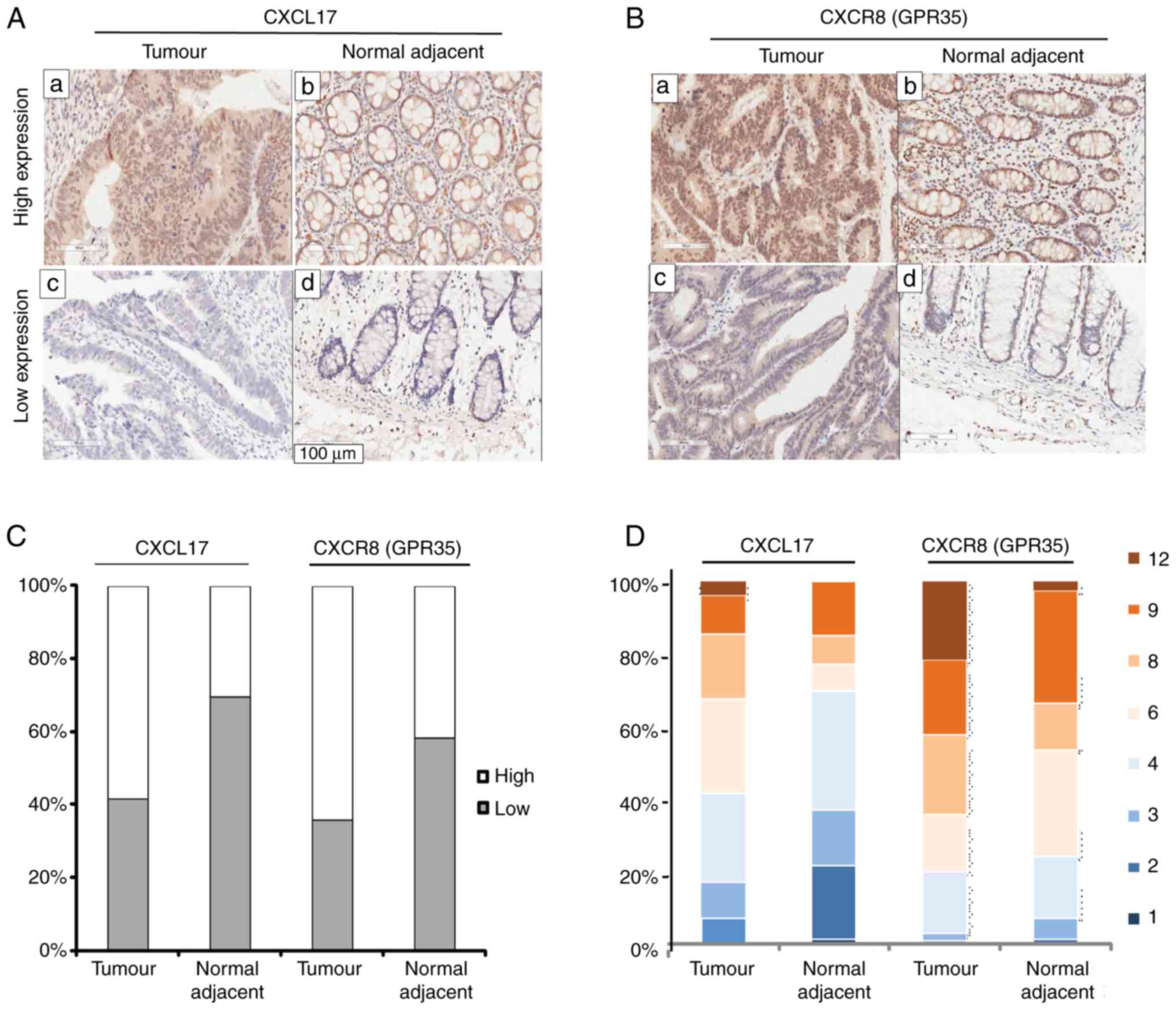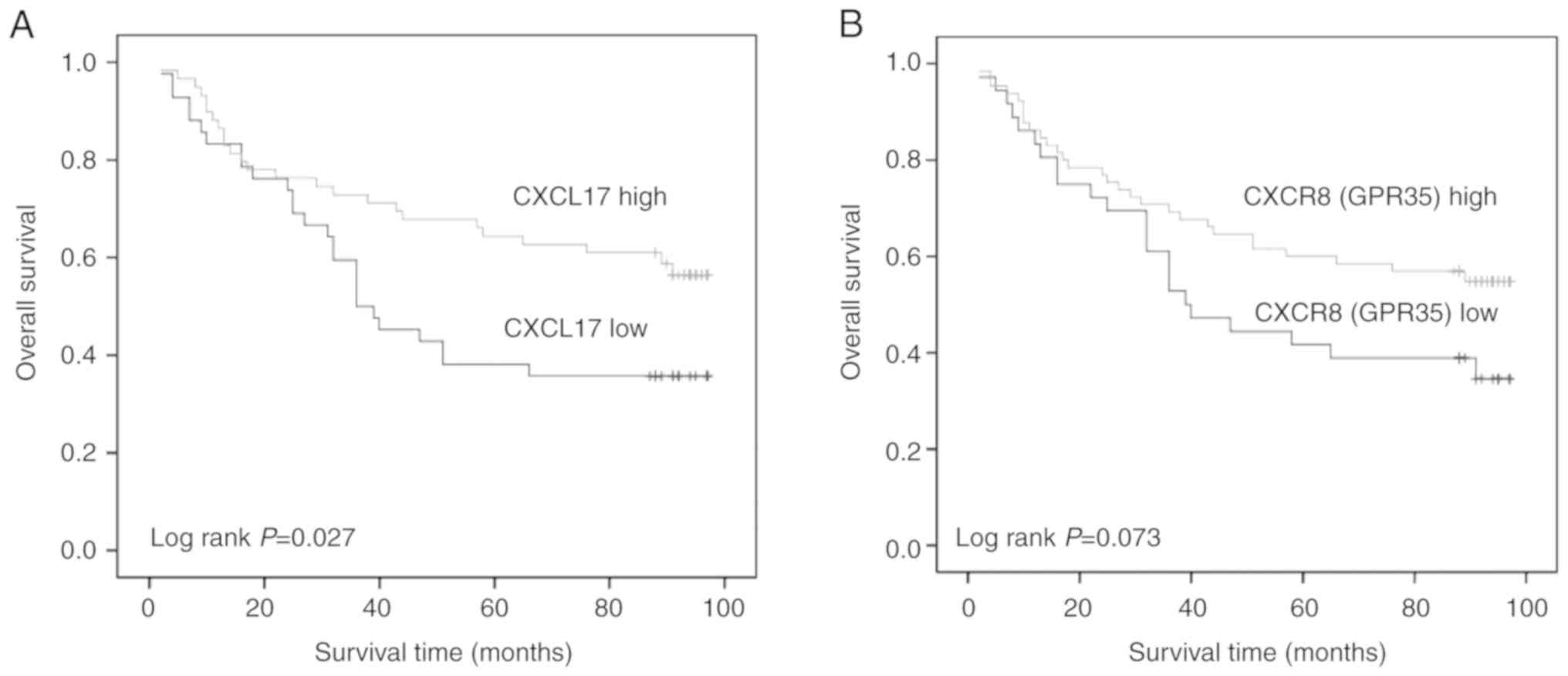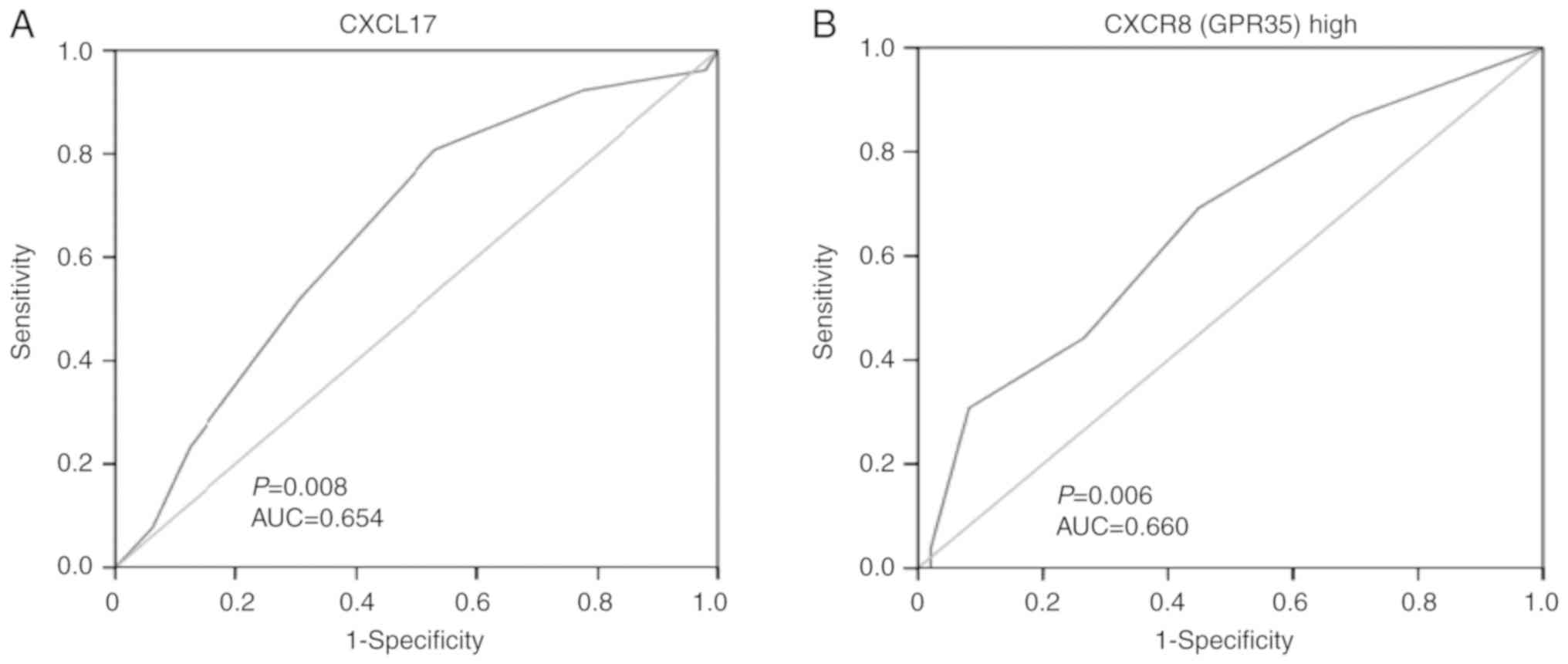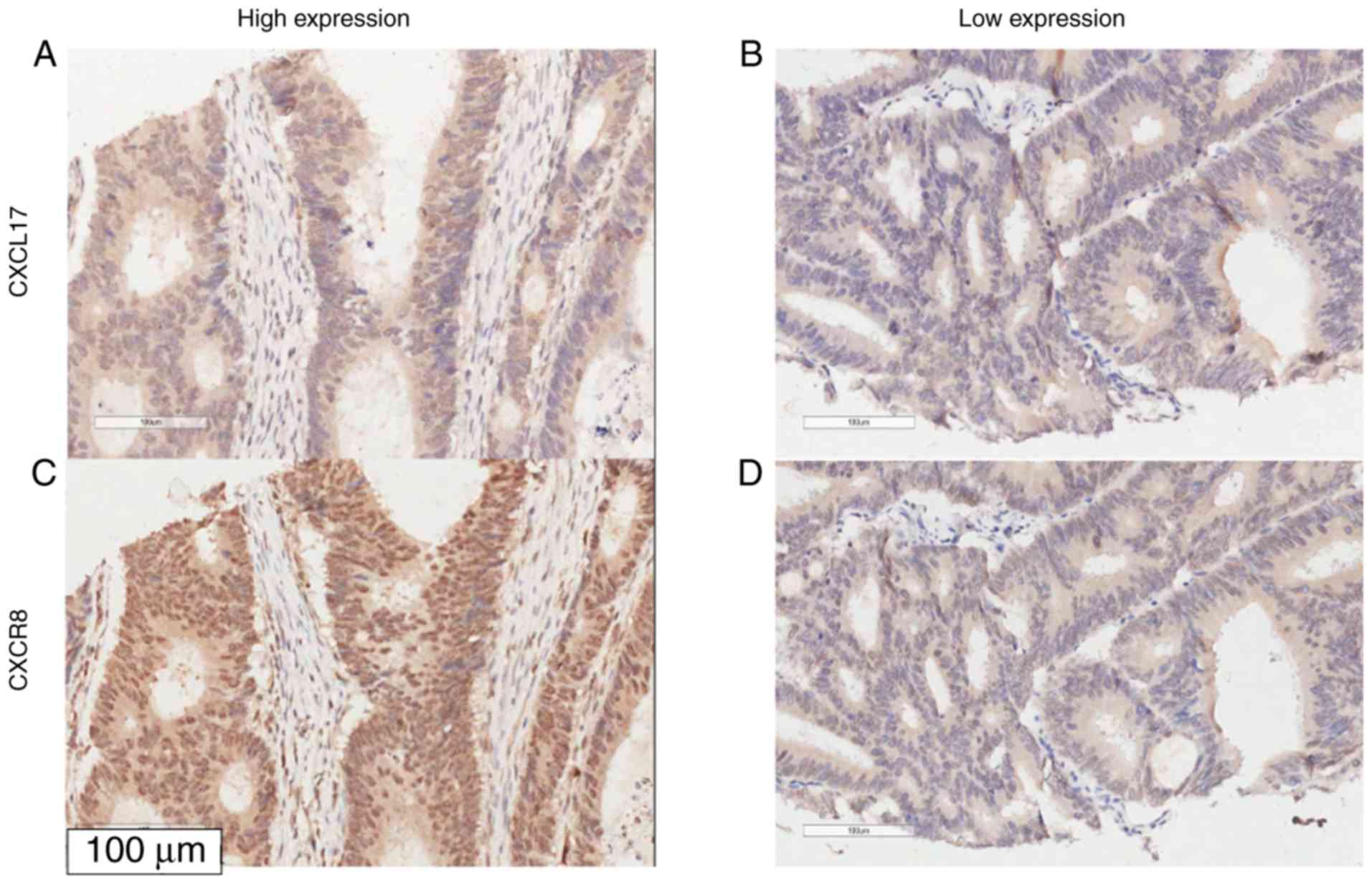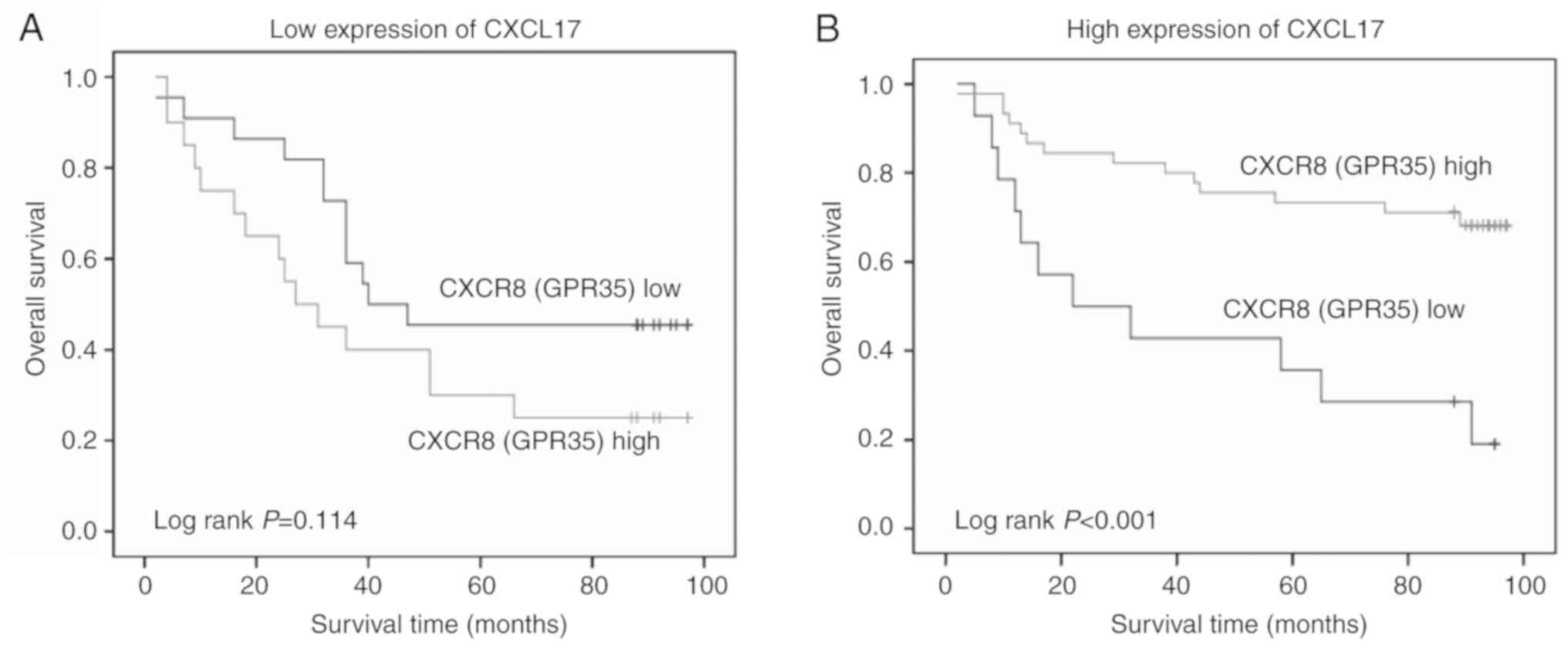|
1
|
Sokol CL and Luster AD: The chemokine
system in innate immunity. Cold Spring Harb Perspect Biol.
7:a0163032015. View Article : Google Scholar : PubMed/NCBI
|
|
2
|
Rotondi M, Chiovato L, Romagnani S, Serio
M and Romagnani P: Role of chemokines in endocrine autoimmune
diseases. Endocr Rev. 28:492–520. 2007. View Article : Google Scholar : PubMed/NCBI
|
|
3
|
Raman D, Baugher PJ, Thu YM and Richmond
A: Role of chemokines in tumor growth. Cancer Lett. 256:137–165.
2007. View Article : Google Scholar : PubMed/NCBI
|
|
4
|
Weinstein EJ, Head R, Griggs DW, Sun D,
Evans RJ, Swearingen ML, Westlin MM and Mazzarella R: VCC-1, a
novel chemokine, promotes tumor growth. Biochem Biophys Res Commun.
350:74–81. 2006. View Article : Google Scholar : PubMed/NCBI
|
|
5
|
Pisabarro MT, Leung B, Kwong M, Corpuz R,
Frantz GD, Chiang N, Vandlen R, Diehl LJ, Skelton N, Kim HS, et al:
Cutting edge: Novel human dendritic cell- and monocyte-attracting
chemokine-like protein identified by fold recognition methods. J
Immunol. 176:2069–2073. 2006. View Article : Google Scholar : PubMed/NCBI
|
|
6
|
Burkhardt AM, Tai KP, Flores-Guiterrez JP,
Vilches-Cisneros N, Kamdar K, Barbosa-Quintana O, Valle-Rios R,
Hevezi P, Zuñiga J, Selman M, et al: CXCL17 is a mucosal chemokine
elevated in idiopathic pulmonary fibrosis that exhibits broad
antimicrobial activity. J Immunol. 188:6399–6406. 2012. View Article : Google Scholar : PubMed/NCBI
|
|
7
|
Hernández-Ruiz M and Zlotnik A: Mucosal
chemokines. J Interferon Cytokine Res. 37:62–70. 2017. View Article : Google Scholar : PubMed/NCBI
|
|
8
|
Matsui A, Yokoo H, Negishi Y,
Endo-Takahashi Y, Chun NA, Kadouchi I, Suzuki R, Maruyama K,
Aramaki Y, Semba K, et al: CXCL17 expression by tumor cells
recruits CD11b+Gr1 high F4/80-cells and promotes tumor progression.
PLoS One. 7:e440802012. View Article : Google Scholar : PubMed/NCBI
|
|
9
|
Saghir FS, Rose IM, Dali AZ, Shamsuddin Z,
Jamal AR and Mokhtar NM: Gene expression profiling and
cancer-related pathways in type I endometrial carcinoma. Int J
Gynecol Cancer. 20:724–731. 2010. View Article : Google Scholar : PubMed/NCBI
|
|
10
|
Mu X, Chen Y, Wang S, Huang X, Pan H and
Li M: Overexpression of VCC-1 gene in human hepatocellular
carcinoma cells promotes cell proliferation and invasion. Acta
Biochim Biophysica Sinica. 41:631–637. 2009. View Article : Google Scholar
|
|
11
|
Ohlsson L, Hammarström ML, Lindmark G,
Hammarstrom S and Sitohy B: Ectopic expression of the chemokine
CXCL17 in colon cancer cells. Br J Cancer. 114:697–703. 2016.
View Article : Google Scholar : PubMed/NCBI
|
|
12
|
Hiraoka N, Yamazaki-Itoh R, Ino Y,
Mizuguchi Y, Yamada T, Hirohashi S and Kanai Y: CXCL17 and ICAM2
are associated with a potential anti-tumor immune response in early
intraepithelial stages of human pancreatic carcinogenesis.
Gastroenterology. 140:310–321. 2011. View Article : Google Scholar : PubMed/NCBI
|
|
13
|
Mao Y, Zhao Q, Yin S, Ding X and Wang H:
Genome-wide expression profiling and bioinformatics analysis of
deregulated genes in human gastric cancer tissue after gastroscopy.
Asia Pac J Clin Oncol. 14:e29–e36. 2018. View Article : Google Scholar : PubMed/NCBI
|
|
14
|
Maravillas-Montero JL, Burkhardt AM,
Hevezi PA, Carnevale CD, Smit MJ and Zlotnik A: Cutting edge:
GPR35/CXCR8 is the receptor of the mucosal chemokine CXCL17. J
Immunol. 194:29–33. 2015. View Article : Google Scholar : PubMed/NCBI
|
|
15
|
Guo YJ, Zhou YJ, Yang XL, Shao ZM and Ou
ZL: The role and clinical significance of the CXCL17-CXCR8 (GPR35)
axis in breast cancer. Biochem Biophys Res Commun. 493:1159–1167.
2017. View Article : Google Scholar : PubMed/NCBI
|
|
16
|
Khandelwal AR, Alam MM, Moore-Medlin T,
Savage HA and Nathan CAO: Role of the CXCL17-CXCR8 (GPR35) axis in
cutaneous squamous cell carcinoma. Cancer Res. 792019.PubMed/NCBI
|
|
17
|
Lan YT, Yang SH, Chang SC, Liang WY, Li
AF, Wang HS, Jiang JK, Chen WS, Lin TC and Lin JK: Analysis of the
seventh edition of american joint committee on colon cancer
staging. Int J Colorectal Dis. 27:657–663. 2012. View Article : Google Scholar : PubMed/NCBI
|
|
18
|
Liu X, Xiao Q, Bai X, Yu Z, Sun M, Zhao H,
Mi X, Wang E, Yao W, Jin F, et al: Activation of STAT3 is involved
in malignancy mediated by CXCL12-CXCR4 signaling in human breast
cancer. Oncol Rep. 32:2760–2768. 2014. View Article : Google Scholar : PubMed/NCBI
|
|
19
|
Wang W, Han T, Tong W, Zhao J and Qiu X:
Overexpression of GPR35 confers drug resistance in NSCLC cells by
β-arrestin/Akt signaling. Onco Targets Ther. 11:6249–6257. 2018.
View Article : Google Scholar : PubMed/NCBI
|
|
20
|
Rashad Y, Olsson L, Israelsson A, Öberg Å,
Lindmark G, Hammarström ML, Hammarström S and Sitohy B: Lymph node
CXCL17 messenger RNA: A new prognostic biomarker for colon cancer.
Tumour Biol. 40:10104283187992512018. View Article : Google Scholar : PubMed/NCBI
|
|
21
|
Ali H, AbdelMageed M, Olsson L, Israelsson
A, Lindmark G, Hammarström ML, Hammarström S and Sitohy B: Utility
of G protein-coupled receptor 35 expression for predicting outcome
in colon cancer. Tumour Biol. 41:10104283198588852019. View Article : Google Scholar : PubMed/NCBI
|
|
22
|
Wang L, Li H, Zhen Z, Ma X, Yu W, Zeng H
and Li L: CXCL17 promotes cell metastasis and inhibits autophagy
via the LKB1-AMPK pathway in hepatocellular carcinoma. Gene.
690:129–136. 2019. View Article : Google Scholar : PubMed/NCBI
|
|
23
|
Li L, Yan J, Xu J, Liu CQ, Zhen ZJ, Chen
HW, Ji Y, Wu ZP, Hu JY, Zheng L and Lau WY: CXCL17 expression
predicts poor prognosis and correlates with adverse immune
infiltration in hepatocellular carcinoma. PLoS One. 9:e1100642014.
View Article : Google Scholar : PubMed/NCBI
|
|
24
|
Wang X, Deavers M, Patenia R, Bassett RL
Jr, Mueller P, Ma Q, Wang E and Freedman RS: Monocyte/macrophage
and T-cell infiltrates in peritoneum of patients with ovarian
cancer or benign pelvic disease. J Transl Med. 4:302006. View Article : Google Scholar : PubMed/NCBI
|
|
25
|
Walczak K, Dabrowski W, Langner E, Zgrajka
W, Piłat J, Kocki T, Rzeski W and Turski WA: Kynurenic acid
synthesis and kynurenine aminotransferases expression in colon
derived normal and cancer cells. Scand J Gastroenterol. 46:903–912.
2011. View Article : Google Scholar : PubMed/NCBI
|
|
26
|
Oka S, Ota R, Shima M, Yamashita A and
Sugiura T: GPR35 is a novel lysophosphatidic acid receptor. Biochem
Biophys Res Commun. 395:232–237. 2010. View Article : Google Scholar : PubMed/NCBI
|
|
27
|
Binti Mohd Amir NAS, Mackenzie AE, Jenkins
L, Boustani K, Hillier MC, Tsuchiya T, Milligan G and Pease JE:
Evidence for the Existence of a CXCL17 receptor distinct from
GPR35. J Immunol. 201:714–724. 2018. View Article : Google Scholar : PubMed/NCBI
|
|
28
|
Park SJ, Lee SJ, Nam SY and Im DS: GPR35
mediates lodoxamide-induced migration inhibitory response but not
CXCL17-induced migration stimulatory response in THP-1 cells; is
GPR35 a receptor for CXCL17? Br J Pharmacol. 175:154–161. 2018.
View Article : Google Scholar : PubMed/NCBI
|















